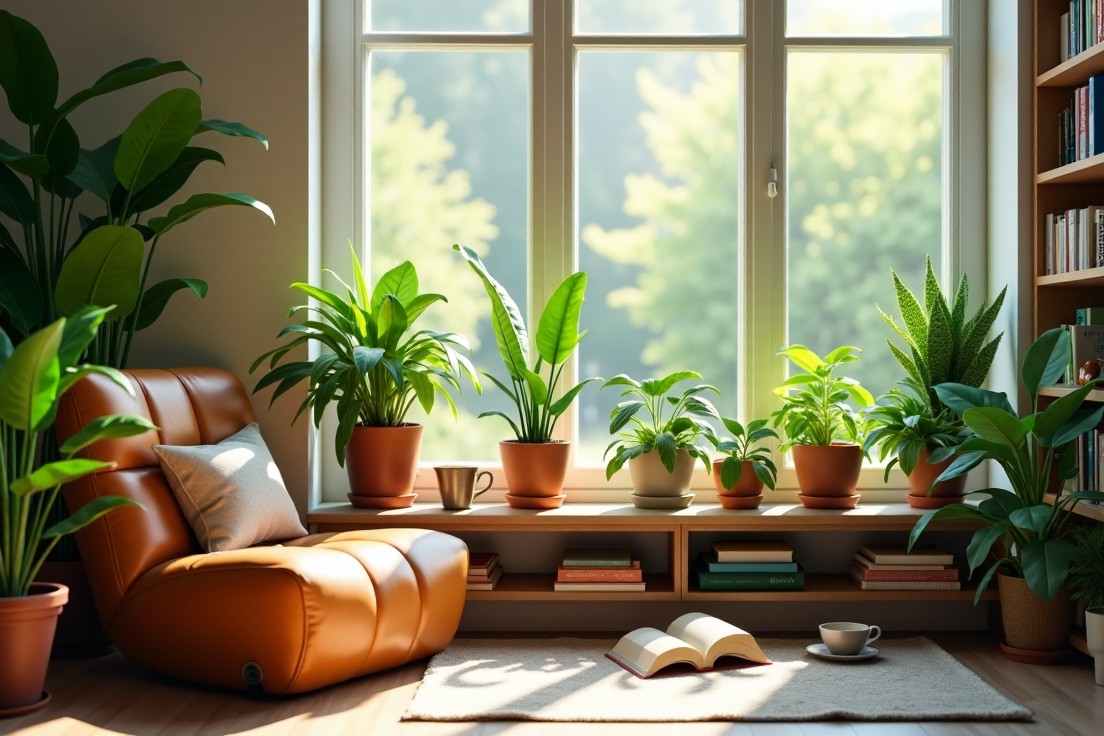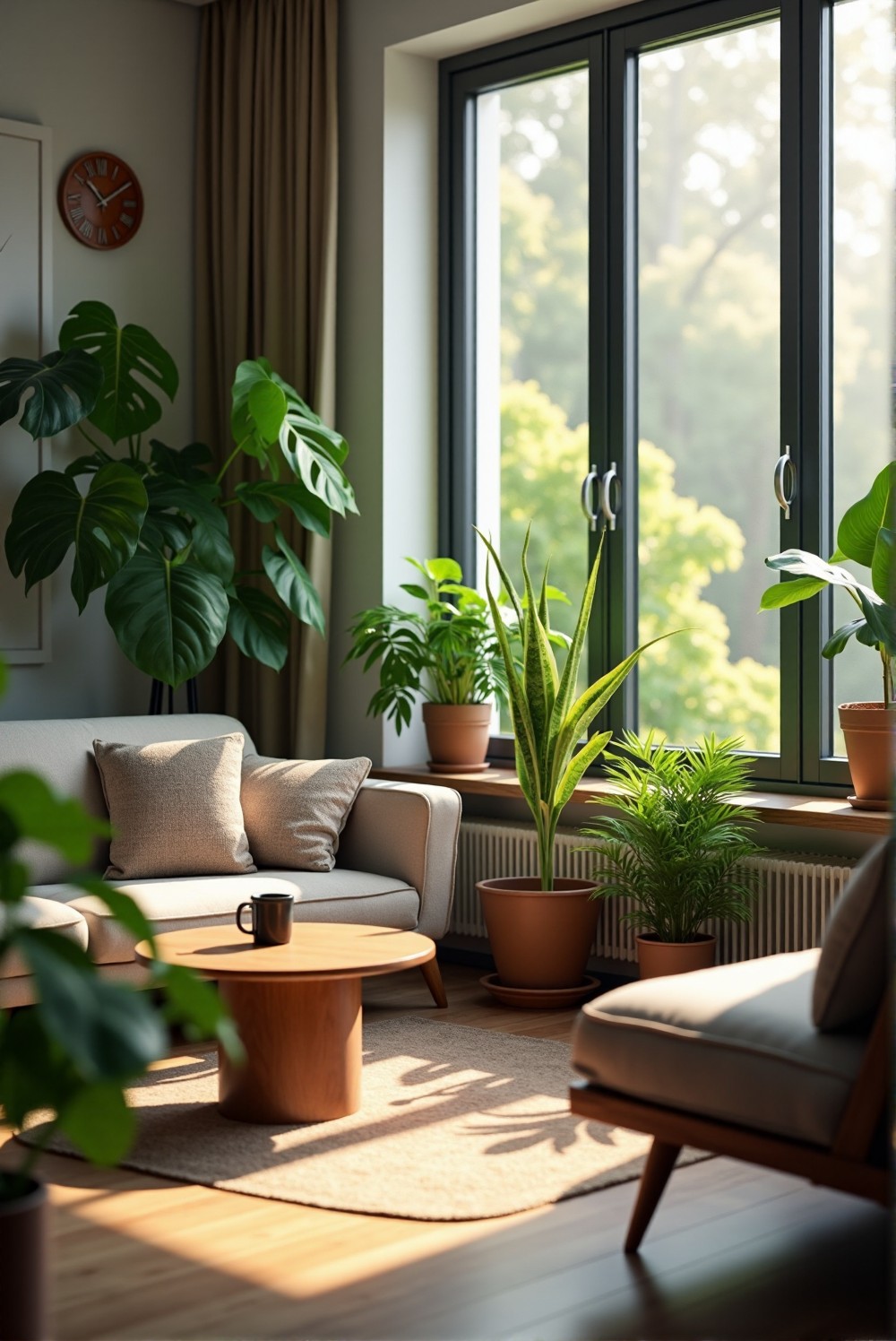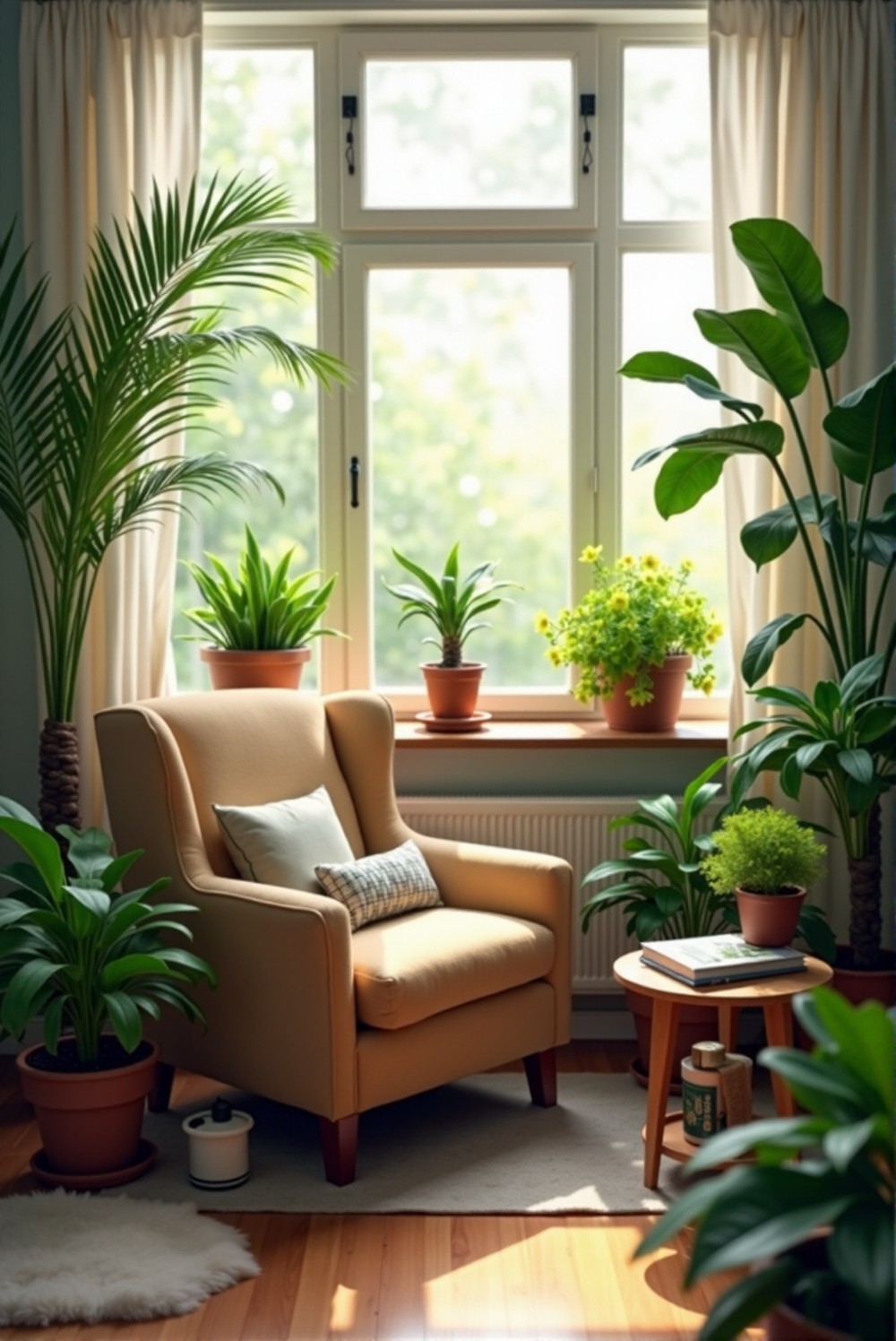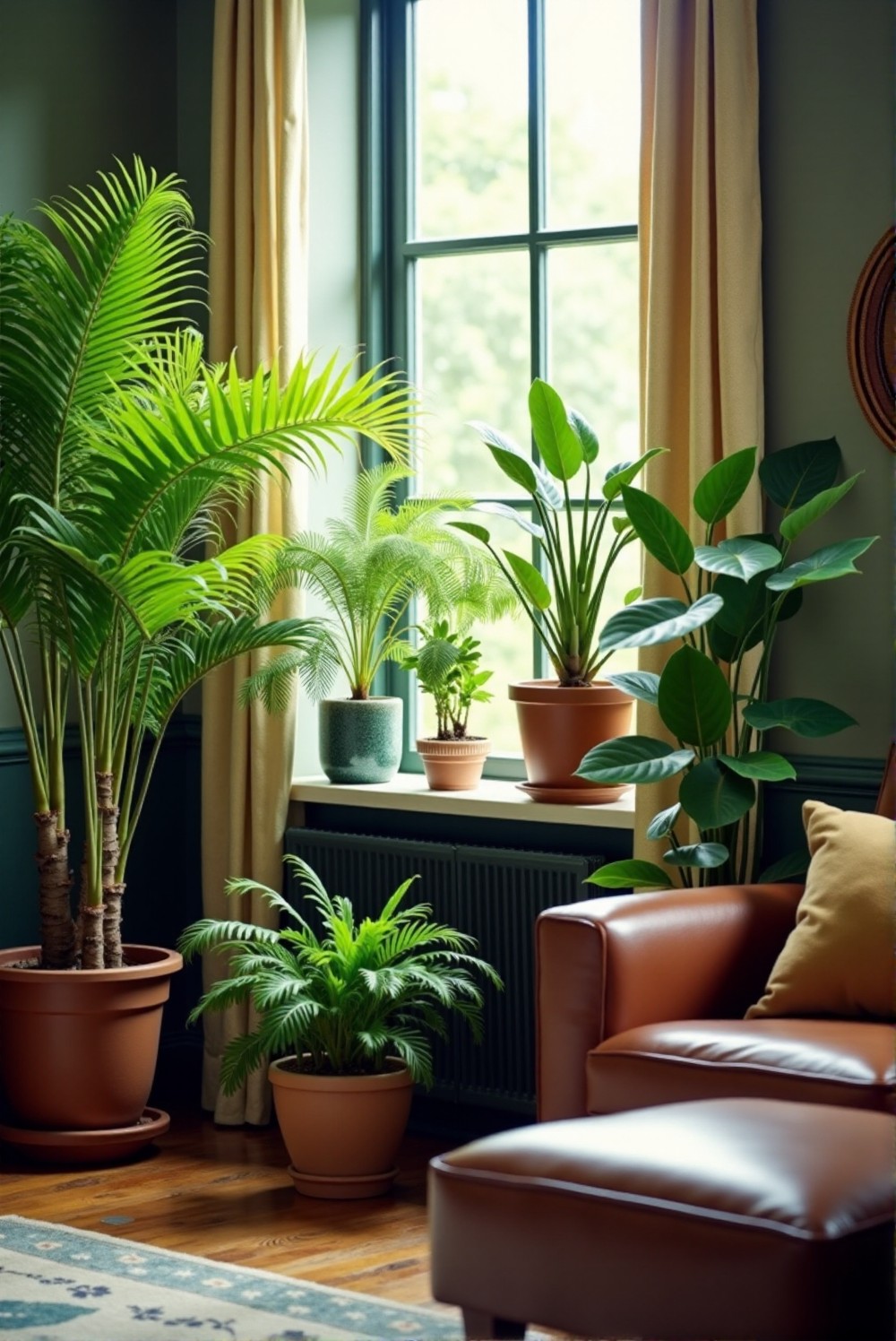
You’ll need to consider how much light, water, and care each type requires. In this blog post, we’ll guide you through the essential steps to assess your space and select the best plants for your lifestyle.
From understanding light conditions to considering temperature and humidity, we’ll cover everything you need to know to create a thriving indoor garden. Let’s get started on this green adventure!
Assessing Your Space for Plants

To make the best choices for your plants, start by evaluating the areas where you want to place them. Look for spots that receive plenty of natural light.
Check how much sunlight enters the room throughout the day. South and west-facing windows usually offer the brightest light, which many plants love.
Understanding the sunlight exposure in your room is crucial for choosing the right plants. Here are some insights to consider:
- South-facing windows can provide direct sunlight for most of the day, benefiting a wide range of plants.
- West-facing windows receive strong afternoon sunlight, making them ideal for sun-loving species.
- Consider using sheer curtains to diffuse intense light while still allowing enough brightness for plant growth.
- Track sunlight changes during different seasons, as the angle and intensity can vary significantly.
- Use light meters or apps to measure the amount of light in different areas of the room accurately.
Consider whether the plants will get a lot of direct sunlight or if some will need bright, indirect light instead.
Next, think about the humidity levels in your space.
Plants like ferns and orchids enjoy higher humidity, while succulents prefer dry air. If your home is humid, you might want to choose tropical plants.
On the other hand, if you live in a dry area, select plants that can thrive in those conditions.
Don’t forget about temperature changes!
Ensure that your plants aren’t placed near heat sources like radiators or air conditioning vents. Consistent temperatures are best for their growth.
Also, remember to think about the size of the plants you want. A big plant can dominate a small space, while tiny plants might get overshadowed in a larger room.
Lastly, consider your daily routine. Will you remember to water and care for the plants?
Some plants need more attention than others. Choose those that match your lifestyle for a stress-free green space.
Evaluating Light Conditions
To find the right plants, pay attention to light conditions in your home. Start by observing when and where sunlight falls in your chosen spaces.
The brightness can change throughout the day. Notice if particular spots are sunnier in the morning or afternoon.
Some plants thrive in direct sunlight. Others do better with bright, indirect light.
For example, cacti and succulents prefer the direct rays of the sun, while many ferns and snake plants like a bit of shade.
If you notice that the light is too harsh, consider adjusting plant placement.
Moving plants a few feet away from the window or using curtains can help. Reflective surfaces nearby can also change how light reaches your plants.
As seasons change, so does the available sunlight. Make sure to evaluate light conditions regularly.
This way, you can keep your plant’s needs in mind throughout the year.
Using light measuring tools can also help.
Light meters are available that gauge the intensity of light. You can use apps to track changes as well.
This information helps ensure you choose plants that will thrive in your specific lighting situation.
Determining Available Space
Start by measuring the space where you want to place your plants. Use a tape measure to check the width, height, and depth of the area.
Knowing these dimensions helps you choose plants that will fit comfortably without overcrowding.
Next, consider the layout of your space.
When planning your garden or indoor plant arrangement, it’s important to consider both the size of your plants and the layout of your space. Here are some helpful points to keep in mind:
- Assess the light conditions of your space to ensure selected plants thrive.
- Factor in the growth rate of your plants to anticipate future space requirements.
- Arranging taller plants at the back or center can create depth and visual interest.
- Group plants with similar water and care requirements together for easier maintenance.
- Take into account the seasonal changes and how they may affect plant placement.
Look for areas that are open and free from obstacles. Think about how your plants will look from different angles.
You want them to enhance your space, not block pathways or views.
Take note of where you might place shelves or plant stands.
These can help you maximize vertical space. Stacking plants can create a beautiful display without taking up too much floor area.
Don’t overlook corners or small nooks. These often provide a perfect spot for smaller plants or pots.
Using these spaces wisely can help create a lush atmosphere without cluttering your environment.
Lastly, weigh your options before making decisions.
It’s easy to get excited about a new plant, but make sure it will thrive in the space you have measured. Choosing the right plant for the space available is key to successful indoor gardening.
Considering Temperature Variations
Temperature plays a big role in how well plants grow. Many indoor plants prefer a stable environment.
They thrive in temperatures between 60F and 75F (15C to 24C). If the temperature falls below or rises above this range, it can stress your plants.
Some plants may even drop their leaves or stop growing entirely.
Be mindful of drafts.
A cold breeze from a window can chill your plants, while warm air from a heater may dry them out. Placing plants in corners or near doors should be done with caution.
Checking the surroundings is crucial to avoid extreme temperature variations.
Seasonal changes can also affect indoor temperatures.
In winter, homes may feel cooler, while summer can bring heat. This makes it vital to monitor how your plants respond during different times of the year.
Adjust their placement accordingly to ensure they remain happy.
You can use thermometers to keep track of the temperature in various areas.
If a space gets too hot or cold, consider moving your plants to a more suitable location. Also, be aware of how your daily activities affect the temperature, like cooking or using electronic devices that generate heat.
Understanding Plant Care Requirements

First, consider the watering needs of your plants. Some plants like to stay moist, while others prefer to dry out between waterings.
Understanding how much water your plants need is essential for their health. Different plants have varying watering preferences. Here is a table that summarizes the watering needs of some common types of plants.
| Plant Type | Watering Preference |
|---|---|
| Succulents | Allow to dry out completely between waterings |
| Ferns | Keep consistently moist |
| Spider Plants | Water when the top inch of soil is dry |
| Peace Lilies | Water when soil feels dry to the touch |
| Orchids | Water when the medium is dry, usually every one to two weeks |
| Cacti | Allow to dry out completely between waterings |
Knowing how often to water is crucial to preventing overwatering or underwatering, both of which can harm your plants.
Next, consider the type of soil your plants need.
Different plants thrive in different kinds of soil. Cacti and succulents need well-draining soil to avoid root rot, while others, like ferns, prefer soil that retains moisture.
Choosing the right soil can make a big difference in a plant’s health.
Fertilization is another important factor.
Some plants benefit from regular feeding during their growing season, while others do not need much at all. Using the proper type of fertilizer can help your plants get the nutrients they need to thrive.
Don’t forget about pests! Checking plants for common pests, such as spider mites or aphids, is vital.
Early detection can help prevent infestations that could damage your plants. Keeping your plants clean and healthy reduces the chance of these problems.
Finally, consider the growth habits of the plants you choose. Some may grow quickly and require repotting sooner than others.
Knowing how fast a plant grows informs you about future care tasks and helps you plan accordingly. By understanding these care requirements, you can create a thriving plant collection that fits your home and routine.
Watering Needs of Different Plants
Overwatering can harm these plants, leading to root rot. On the other hand, ferns prefer consistent moisture.
They need to be watered regularly to keep their soil damp, but not soggy.
Spider plants and peace lilies have moderate needs.
For spider plants, check the top inch of soil; once it feels dry, it’s time to water. Peace lilies want a bit of dryness, too, so water them when the soil feels dry to the touch.
Proper watering is essential for the health of your indoor plants. Here are some helpful tips to ensure your spider plants and peace lilies thrive:
- Always check the moisture level in the top inch of soil before watering.
- Use room temperature water for optimal absorption.
- Avoid letting spider plants sit in standing water to prevent root rot.
- Peace lilies will benefit from humidity; consider misting them occasionally.
- Observe your plants’ leaves for signs of over or under-watering, such as yellowing or wilting.
Orchids can be a bit tricky; they generally prefer watering every one to two weeks when their medium is dry.
Understanding these differences helps create a thriving environment.
Choose plants that match your watering routine. If you tend to forget, pick hardier plants that are forgiving.
Matching your habits with plant needs will ensure your green friends grow beautifully.
Humidity Levels and Preferences
Some love high humidity, while others do better in drier conditions. For instance, tropical plants such as ferns and peace lilies thrive in moist air.
They often require humidity levels of 50% or higher to flourish. In contrast, cacti and succulents prefer a dry environment with lower humidity.
Understanding the environmental needs of different plants is essential for their care and growth. Here are some key points to consider:
- Tropical plants typically thrive in warm environments with abundant moisture.
- High humidity can encourage vibrant growth and flowering in humidity-loving plants.
- Cacti are adapted to survive in arid conditions, storing water in their bodies.
- Soil preferences differ: tropical plants often need well-draining soil that retains some moisture, while cacti need sandy, quick-draining soil.
- Temperature fluctuations can affect humidity levels, impacting plant health and growth.
Too much moisture can lead to issues like mold or root rot for these plants.
To gauge the humidity level in your space, consider using a hygrometer.
This device can help you measure the moisture in the air accurately. If your home has low humidity, you might want to mist your plants or use a humidifier to create a friendlier environment for moisture-loving species.
On the other hand, if your space is too humid, good airflow is essential. This can keep the air moving and help prevent fungal problems.
Choosing the right plants for your living space involves understanding their humidity needs. If you enjoy tropical plants, ensure you can provide a humid environment.
Alternatively, if you prefer low-maintenance plants, succulents are typically much easier to care for in drier conditions. Matching plant preferences with your home’s humidity can greatly improve their chances of thriving and keeps your indoor garden looking beautiful.
Fertilization and Growth Cycles
Fertilizers provide these essential nutrients, helping plants reach their full potential. Different plants have different needs, so understanding what your specific plants require is important.
For instance, leafy plants typically need more nitrogen, while flowering plants may benefit more from potassium and phosphorus.
During the growing season, plants are especially active.
This period usually happens in spring and summer. Applying fertilizer at this time can lead to the best growth.
However, in the fall and winter, many plants slow down. They may not need as much food, so it’s wise to reduce fertilization during these seasons.
When choosing fertilizer, consider its form. Granular fertilizers release nutrients slowly, while liquid fertilizers provide a quick boost.
Always follow the instructions on the packaging to avoid over-fertilizing, which can harm your plants. The frequency of application can vary depending on the type of plant and fertilizer used.
Monitoring your plants’ health provides clues about their needs. If they appear yellow or are not growing well, it might be time to adjust your fertilization routine.
Observations will help ensure that your plants thrive based on their unique growth cycles.
Choosing Plants That Fit Your Lifestyle

These plants tend to thrive with minimal attention.
For those who enjoy gardening and have time to spare, consider varieties that require more care, like bonsai trees or orchids.
They will need regular watering, specific humidity levels, and possibly fertilization. Make sure you will enjoy caring for them.
Also, look at your home environment. If you have pets, ensure the plants you choose are safe for them.
Some plants can be toxic, so research is key. Depending on the available light, select plants that will thrive in your home’s conditions.
Measure how much time you can dedicate to plant care each week.
Think about the aesthetic you want to create.
Taking care of plants can be a rewarding hobby. Before you start, consider the following points to ensure you create a thriving green space:
- Assess your weekly schedule to find consistent time slots for plant care.
- Choose plants that align with the time you can dedicate for maintenance.
- Decide on a cohesive color scheme and style for your plant arrangement.
- Consider the lighting conditions in your space and select plants accordingly.
- Research care requirements for each plant to ensure they fit your lifestyle.
Do you prefer a jungle-like ambiance or a minimalist look? Choose plants that contribute to the vibe you wish to achieve.
Incorporating different sizes, shapes, and colors can help you create a beautiful space that reflects your style.
Lastly, pay attention to how often you’ll be home to care for your plants.
If you’re out of town often, consider self-watering pots or plants that can handle some neglect. Matching your lifestyle with the right plant choices ensures a thriving and enjoyable indoor garden.
Selecting Low-Maintenance Options
Consider varieties like succulents, snake plants, or pothos. They are known for being hardy and adaptable.
Succulents store water in their leaves, making them perfect for busy people. They need little watering, usually just when the soil is completely dry.
Snake plants can survive in low light and don’t need frequent watering either. Pothos is another easy choice, known for its ability to grow in various lighting conditions.
Look for plants that can tolerate some neglect. Research the care levels for each plant type.
It’s important to choose according to how much time you have. If you travel often or lead a busy lifestyle, these plants will suit you well.
When selecting plants for your home or office, it’s crucial to consider the amount of time you can dedicate to their care. Here are some quick options that fit into a busy lifestyle:
- Choose low-maintenance plants that require minimal watering, such as succulents and cacti.
- Opt for hardy varieties that thrive in various light conditions, making them adaptable to different environments.
- Consider plants that can go longer periods without attention, like snake plants and ZZ plants.
- Utilize self-watering pots to help manage your plant care effortlessly.
- Look for plants that have air-purifying qualities, enhancing your environment while being easy to care for.
Aself-watering pot can also make life easier. These pots keep the soil moist for you, reducing the need to water so often.
Remember to place any low-maintenance plants in areas where they will thrive, with the right light and temperature.
By choosing hardier plants, you can enjoy greenery without the stress of constant care.
Having low-maintenance options allows you to focus on enjoying your plants rather than worrying about them.
Picking Pet-Friendly Plants
To ensure your furry friends stay safe, choose pet-friendly plants. Some excellent options include spider plants, Boston ferns, and bamboo palms.
These plants are not only safe but also beautiful additions to your space.
Spider plants are hardy and prefer indirect sunlight.
They help improve indoor air quality, making them a great choice for homes. Boston ferns thrive in humid environments and enjoy bright, indirect light.
Bamboo palms are easy to care for and can grow in various light conditions. They’re excellent for adding a tropical feel to your home.
Always double-check plants before bringing them home. The ASPCA has a list of toxic and non-toxic plants to help guide your choices.
Creating a safe environment for your pets while enjoying the beauty of plants is possible with careful selection.
If your pets are curious, it’s wise to place any plants out of their reach.
Hanging pots or high shelves can be perfect for keeping plants safe. By choosing the right plants and placing them thoughtfully, you can make your home both attractive and pet-friendly.
Finding Plants for Allergies
Peace lilies and snake plants are great options because they are known for being low in allergens. Plants like these can help improve indoor air quality too.
Additionally, you might want to focus on species with thicker, waxy leaves. These types typically trap dust and allergens rather than allowing them to float around in the air.
Examples include rubber plants and pothos. They are easy to care for and suitable for different lighting conditions.
It can also be helpful to choose plants that won’t require frequent flowering. Flowering plants may release more pollen, which can trigger allergic reactions.
When considering plants for your space, it’s important to think about their flowering habits and the potential impact on allergies. Here are some tips to help you select suitable plants:
- Opt for low-pollen or non-flowering varieties to minimize allergic reactions.
- Research plants that are known for their air-purifying qualities without frequent blooms.
- Choose native species that are adapted to your local environment and require less maintenance.
- Consider indoor plants that are less likely to produce pollen, such as certain ferns or foliage plants.
- Maintain a regular cleaning routine for your plants to reduce dust and pollen accumulation.
Instead, look for greenery that will stay lush without blooms, like ferns or ZZ plants.
Lastly, think about the care you are able to give.
Some plants prefer high humidity and regular watering, while others thrive on little attention. Choose ones suited to your lifestyle so you can keep them healthy without added stress.
By picking the right types of plants, you can enjoy greenery in your space without increasing allergy symptoms. Make sure to do a little research on the specific needs and benefits of each plant you consider to find the best fit for your home.
Frequently Asked Questions
Here are some frequently asked questions regarding selecting the right plants for your space and lifestyle.
How do I assess the light conditions in my home for plants?
Start by observing where sunlight falls in your chosen spaces, noting the brightness at different times of the day. South-facing windows typically allow for more direct sunlight, which is ideal for many plants.
Use sheer curtains if necessary to diffuse too much direct light, and consider using light meters or apps to measure intensity accurately. Regular evaluations of light conditions can help you adjust plant placements as seasons change.
What factors should I consider regarding temperature for my plants?
Temperature is crucial for plant growth, with most indoor plants thriving in a range of 60F to 75F (15C to 24C). Be aware of temperature fluctuations caused by drafts, heat sources, or air conditioning as these can stress your plants.
Monitoring the temperature throughout different seasons and adjusting plant placement accordingly can help maintain a stable environment. Checking with a thermometer can guide you in making sure your plants are in the best possible conditions.
How can I ensure I’m selecting plants that fit my lifestyle?
Assess the amount of time you can dedicate to plant care each week to select suitable varieties. If you’re often busy, low-maintenance plants like succulents or snake plants, which can tolerate less frequent watering, may be ideal.
Consider your living environment, particularly if you have pets, as some plants can be toxic. Your choice of plants should also align with the aesthetics you wish to achieve in your home.
What are the primary care requirements I should keep in mind when selecting plants?
Understanding the watering needs of your plants is paramount as different varieties have varying requirements. For example, succulents prefer to dry out completely between waterings, whereas ferns like consistent moisture.
Additionally, consider soil types and fertilization needs that match the plant species you choose. Monitoring for pests and adjusting care based on growth habits will ensure your plants thrive.
Are there plants that are safe for homes with pets?
Yes, there are many plants that are safe for pets. Spider plants, Boston ferns, and bamboo palms are excellent options that not only enhance aesthetics but are also non-toxic to pets.
Before bringing any plants into your home, check their safety against lists provided by organizations like the ASPCA, which outlines toxic and non-toxic plants. This diligence can help you avoid potentially harmful situations for your furry friends.
How do I choose plants that can help with allergy issues?
If you suffer from allergies, opt for plants like peace lilies or snake plants, which are known for having low allergen production. Choosing plants with thicker, waxy leaves can also help as they trap dust and allergens rather than allowing them to circulate in the air.
Avoid flowering plants that may produce pollen, as this can exacerbate allergies. Regular cleaning of your plants will also help reduce dust accumulation, contributing to a healthier indoor environment.
Conclusion
Whether you prefer low-maintenance options or are excited to care for a variety of plants, think about what works best for your lifestyle. Always keep your needs and preferences in mind when selecting plants, as this will make caring for them more enjoyable and fulfilling.
With the right choices, you can create a beautiful indoor garden that not only enhances your space but also brings you joy and relaxation. Happy planting!